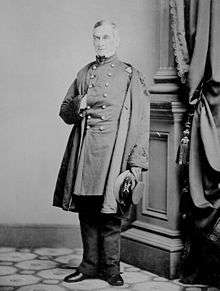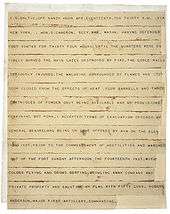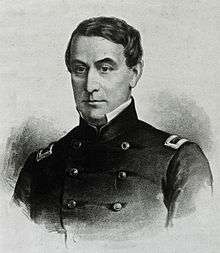Robert Anderson (Civil War)
| Robert Anderson | |
|---|---|
|
Lithograph of Major Robert Anderson | |
| Born |
June 14, 1805 Louisville, Kentucky, United States |
| Died |
October 26, 1871 (aged 66) Nice, France |
| Place of burial | West Point Cemetery |
| Allegiance |
Union |
| Service/branch |
United States Army Union Army |
| Years of service | 1825–1863 |
| Rank |
|
| Unit |
3rd Regiment of Artillery 1st Regiment of Artillery |
| Commands held |
Fort Sumter Department of the Cumberland Fort Adams |
| Battles/wars | |
Robert Anderson (June 14, 1805 – October 26, 1871) was a United States Army officer during the American Civil War. To many, he was a hero who defied the Confederacy and upheld Union honor in the first battle of the American Civil War at Fort Sumter in April 1861. The Confederates bombarded the fort and forced its surrender to start the war. After Sumter fell, Anderson was promoted to brigadier general and given command of Union forces in Kentucky, but was removed late in 1861 and reassigned to Rhode Island, before retiring from military service in 1863.
Early life and career
Anderson was born at "Soldier's Retreat," the Anderson family estate near Louisville, Kentucky. His father, Richard Clough Anderson, Sr. (1750–1826), served in the Continental Army as an aide-de-camp to the Marquis de Lafayette during the American Revolutionary War, and was a charter member of the Society of the Cincinnati; his mother, Sarah Marshall (1779–1854), was a cousin of John Marshall, the fourth Chief Justice of the United States.[1] He graduated from the United States Military Academy (West Point) in 1825, and received a commission as a second lieutenant in the 3rd Regiment of Artillery.
A few months after graduation, he became private secretary to his older brother Richard Clough Anderson, Jr., who was serving as the US Minister to Gran Colombia. He served in the Black Hawk War of 1832 as a colonel of Illinois volunteers, where he had the distinction of twice mustering Abraham Lincoln in and once out of army service. He also was in charge of transporting Black Hawk to Jefferson Barracks after his capture, assisted by Jefferson Davis[2]
Returning to regular Army service as a first lieutenant in 1833, he served in the Second Seminole War as an assistant adjutant general on the staff of Winfield Scott, and was promoted to captain in October 1841.
In the Mexican–American War, he participated in the Siege of Vera Cruz, March 9–29, 1847, the Battle of Cerro Gordo, April 17–18, 1847, the Skirmish of Amazoque, May 14, 1847, and Battle of Molino del Rey on September 8, 1847. He was severely wounded at Molino del Rey while assaulting enemy fortifications, for which he received a brevet promotion to major.
Due to his wounds, Anderson was on sick leave of absence during 1847–48. He was then in garrison at Fort Preble, Maine from 1848 to 1849. He then served from 1849 to 1851 as a member of Board of Officers to devise "A Complete System of Instruction for Siege, Garrison, Seacoast, and Mountain Artillery," which was adopted on May 10, 1851. He then returned to garrison duty at Fort Preble from 1850 to 1853.[3]
He eventually received a permanent promotion to major of the 1st Regiment of Artillery in the Regular Army on October 5, 1857. He was the author of Instruction for Field Artillery, Horse and Foot in 1839.[4]
Civil War
Fort Sumter

When South Carolina seceded In December 1860, Major Anderson, a pro-slavery, former slave-owner from Kentucky, remained loyal to the Union. He was the commanding officer of United States Army forces in Charleston, South Carolina, the last remaining important Union post in the Confederacy. He moved his small garrison from Fort Moultrie, which was indefensible, to the more modern, more defensible, Fort Sumter in the middle of Charleston Harbor. South Carolina leaders cried betrayal, while the North celebrated with enormous excitement at this show of defiance against secessionism. In February 1861 the Confederate States of America was formed and took charge. Jefferson Davis, the Confederate President, ordered the fort be captured. The artillery attack was commanded by Brig. Gen. P. G. T. Beauregard, who had been Anderson's student at West Point. The attack began April 12, 1861, and continued until Anderson, badly outnumbered and outgunned, surrendered the fort on April 14. The battle began the American Civil War. No one was killed in the battle on either side, but one Union soldier was killed and one mortally wounded during a 50-gun salute.
Status as national hero
Robert Anderson's actions in defense of Fort Sumter made him an immediate national hero. He was promoted to brigadier general, effective May 15. Anderson took the fort's 33-star flag with him to New York City, where he participated in a Union Square patriotic rally that was the largest public gathering in North America up to that time.
Symbolism of the American flag
The modern meaning of the American flag, according to Adam Goodheart in 2011, was forged by Anderson's stand at Fort Sumter. During the war the flag was used throughout the North to symbolize American nationalism and rejection of secessionism. Goodheart explains the flag was transformed into a sacred symbol of patriotism:
Before that day, the flag had served mostly as a military ensign or a convenient marking of American territory ... and displayed on special occasions like the Fourth of July. But in the weeks after Major Anderson's surprising stand, it became something different. Suddenly the Stars and Stripes flew ... from houses, from storefronts, from churches; above the village greens and college quads. ... [T]hat old flag meant something new. The abstraction of the Union cause was transfigured into a physical thing: strips of cloth that millions of people would fight for, and many thousands die for.[5]

Assignments
Anderson then went on a highly successful recruiting tour of the North. His next assignment placed him in another sensitive political position, commander of the Department of Kentucky (subsequently renamed the Department of the Cumberland), in a border state that had officially declared neutrality between the warring parties. He served in that position from May 28, 1861. Historians commonly attribute failing health as the reason for his relinquishment of command to Brig. Gen. William T. Sherman, on October 7, 1861. But a letter from Joshua Fry Speed, Lincoln's close friend, suggests Lincoln's preference for Anderson's removal. Speed met with Anderson and found him reluctant to implement Lincoln's wishes to distribute rifles to Unionists in Kentucky. Anderson, Speed wrote to Lincoln on October 8, "seemed grieved that [he] had to surrender his command ... [but] agreed that it was necessary and gracefully yielded."
In 1862 Anderson was elected an honorary member of the New York Society of the Cincinnati. Anderson's grandnephew, Ambassador Larz Anderson, was highly active in the Society.
General Anderson's last assignment of his military career was a brief period as commanding officer of Fort Adams in Newport, Rhode Island, in August 1863. By coincidence, Fort Adams had been General Beauregard's first assignment after his graduation from West Point.
Anderson officially retired from the Army on October 27, 1863, "for Disability resulting from Long and Faithful Service, and Wounds and Disease contracted in the Line of Duty", but continued to serve on the staff of the general commanding the Eastern Department, headquartered in New York City, from October 27, 1863 until January 22, 1869.[6]
On February 3, 1865, Anderson was breveted to the rank of major general of "gallantry and meritorious service" in the defense of Fort Sumter.
Later life
After Robert E. Lee's surrender at Appomattox and the effective conclusion of the war, Anderson returned to Charleston in uniform and, four years after lowering the 33-star flag in surrender, raised it in triumph over the recaptured but badly battered Fort Sumter during ceremonies there on April 14, 1865, mere hours before Lincoln's assassination.[7]
After the war, he became a companion of the Military Order of the Loyal Legion of the United States.
In 1869, he discussed the future of the U.S. Army with the "Father of the United States Military Academy," Brevet Major General Sylvanus Thayer. An outcome of that visit was establishment of the Military Academy's Association of Graduates (AoG).[8]
Anderson died in Nice, France, seeking a cure for his ailments. He was later interred at West Point Cemetery.
Family

Anderson's brother, Charles Anderson, served as Governor of Ohio from 1865 to 1866. A second brother, Larz Anderson II was the father of Nicholas Longworth Anderson who served as a general in the Union Army. Nicholas' son, Larz Anderson III, was a diplomat and a leading member of the Society of the Cincinnati.
Another brother, William Marshall Anderson, was a Western explorer and Ohio attorney. A zealous Catholic and Confederate sympathizer, he briefly moved to Mexico during the reign of Emperor Maximilian in hopes of establishing a Confederate colony there.[9][10] W. Marshall Anderson's son, Thomas M. Anderson, was a brigadier general who fought in the Spanish–American War and Philippine–American War.
Robert Anderson married Eliza Bayard (1828–1905) with whom he had five children: Marie (1849–1925), Sophie (1852–1934), Eliza, Robert Jr. (1859–1879) and Duncan.[11] Anderson was the great-grandfather of actor Montgomery Clift through his daughter Maria.,[12] although this relationship has not been definitively established by genealogical sources. Allegedly, the doctor who delivered Ethel Anderson Clift told her when she an adult that she was the illegitimate daughter of Maria Anderson and Woodbury Blair, but no documentation exists to verify the relationship.[13] but the legend continues. Virtually all sources that advance this theory reference Ethel's own statements or Clift's biographies.[14]
See also
Notes
- ↑ "ANDERSON FAMILY PAPERS 1810–1848".
- ↑ "Robert Anderson to E. B. Washburne". Journal of the Illinois State Historical Society. 10. October 1, 1917. Retrieved July 22, 2015.
- ↑ Register of Graduates of the United States Military Academy. George W. Cullum. Vol. I. pg. 347–349.
- ↑ Eicher, p. 105.
- ↑ Adam Goodheart (2012). 1861: The Civil War Awakening. Vintage Books (reprint). p. 22. ISBN 978-1-4000-3219-8. Retrieved July 31, 2015 – via books.google.com.
- ↑ Register of Graduates of the United States Military Academy. George W. Cullum. Vol. 1. pg. 349.
- ↑ Anderson poster, Fort Sumter National Monument, Charleston, South Carolina
- ↑ Kershner, James William, Sylvanus Thayer – A Biography, Arno Press, New York, 1982, p. 329.
- ↑ Anderson, William Marshall (edited by Ramon Eduardo Ruiz), An American in Maximilian's Mexico, 1865–1866; the diaries of William Marshall Anderson, Huntington Library, San Marino, 1959, 132p.
- ↑ This and other Anderson family papers are kept at the Huntington Library in California:Anderson Family Papers 1810–1848.
- ↑ [Encyclopedia of Biography of New York: A Life Record of Men and Women Whose Sterling Character and Energy and Industry Have Made Them Preëminent in Their Own and Many Other States, Volume 1 (Google eBook), p.182]
- ↑ "Family relationship of Maj. Gen. Robert Anderson and Montgomery Clift via Maj. Gen. Robert Anderson".
- ↑ "RootsWeb's WorldConnect Project: The Ancestry of Overmire Tifft Richardson Bradford Reed".
- ↑ Bosworth, Patricia, Montgomery Clift: A Biography.
References
- Eicher, John H., and Eicher, David J., Civil War High Commands, Stanford University Press, 2001, ISBN 0-8047-3641-3.
- Lawton, Eba Anderson, Major Robert Anderson and Fort Sumter, 1861 (New York, 1911).
- Warner, Ezra J., Generals in Blue: Lives of the Union Commanders, Louisiana State University Press, 1964, ISBN 0-8071-0822-7.
- "Robert Anderson Biography". Retrieved October 1, 2006.
- Civil War Officers
- Robert Anderson to Abraham Lincoln, September 16, 1861, and Joshua F. Speed to Lincoln, October 7, 1861, both in Abraham Lincoln Papers, Library of Congress.
